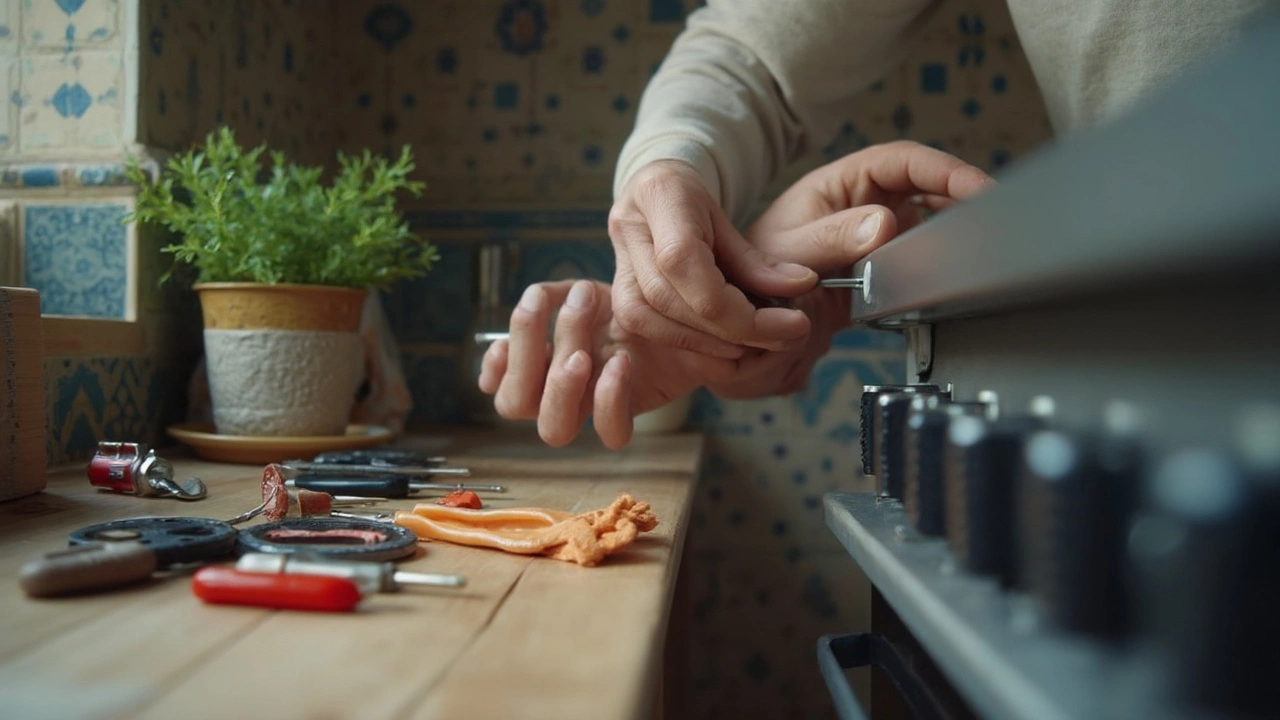Cookers don’t just break on a slow Tuesday—they pick the worst times, like when you're about to cook dinner for friends. Here’s something a lot of folks don’t realize: most cooker problems are actually pretty straightforward to spot and fix yourself. Whether it’s an electric stove that won’t heat up, a gas cooker that won’t ignite, or a dial that’s stuck, there’s usually a reason (and a fix) that doesn’t require a toolbox the size of your kitchen.
Start simple. Don’t bother taking anything apart yet. Check if the appliance is plugged in right and the switch is on. You’d be surprised how often cookers “break” because of a loose plug or a tripped fuse. If it’s a gas model, double-check that the gas supply is open and there’s no weird smell that might signal a leak—if you smell gas, step away and call a pro, fast. For electric cookers, pop over to your breaker box and make sure nothing’s tripped. Sometimes, a simple reset is all it takes to get things sizzling again.
It’s not just about getting things working—it’s about staying safe, too. Don’t touch broken wires or open up panels unless the cooker is completely off and unplugged. For gas, never poke around with an open flame near the appliance. Got a user manual? Grab it—they often hide simple troubleshooting guides that can save you time and money. If you can’t find the paper version, most brands put them online for free.
- Common Cooker Problems You Can Fix Yourself
- Safety First: What to Check Before Repairing
- Step-by-Step Repairs and Handy Tips
- When to Call a Professional
Common Cooker Problems You Can Fix Yourself
Most issues with a cooker don’t need a repair shop visit or expensive parts. The trick is to spot the usual suspects before you think about replacing the whole thing. Here’s what trips up most folks:
- Cooker repair almost always starts with checking the power. If your cooker is dead, see if the outlet works. Test it with another small appliance. No power? Flip the breaker or swap the fuse.
- Uneven heating or not heating at all? Electric cookers often get a build-up on their elements, or sometimes a burner just burns out. You can spot a failed element because it’ll look broken, discolored, or not glow red hot. Gas cookers may have clogged burner holes—poke them clean with something non-metallic (like a toothpick, not a needle).
- The oven’s thermostat isn’t working right? Ovens that run too hot or cold usually have a dodgy thermostat or temperature sensor. To spot the issue, use a simple oven thermometer you can stick inside and compare the actual temp to what the dial says. If it’s way off, the sensor might need swapping.
- Stuck knobs or buttons? Food spills can turn switches sticky. Pop the knob off (most pull straight out) and wash it in warm soapy water. If it won’t budge, a little wiggle usually helps—just don’t force it. Dials that keep spinning may just need to be pressed back into place on their posts.
- Sparking? Gas cookers sometimes won’t click when you turn them on if there’s food stuck on the igniter. A quick brush with a dry, clean toothbrush is often all you need. For electric sparkers, let it dry completely before you try again.
| Problem | Quick Fix | Average Time to Repair (minutes) |
|---|---|---|
| Cooker won't turn on | Check power outlet and fuse | 5 |
| Uneven heating | Clean element or burner | 10 |
| Oven temperature wrong | Test/replace thermostat | 15-30 |
| Stuck knobs | Clean and reseat knob | 5 |
| Sparking issues | Clean igniter | 3 |
Keep in mind, if you hear popping, smell burning without explanation, or if repairs feel out of your depth, it’s smart to stop and call a pro. Otherwise, most problems just need a steady hand and a bit of patience.
Safety First: What to Check Before Repairing
Before grabbing your screwdriver, put safety at the top of your to-do list. A cooker repair isn’t worth a burned finger or worse. Start by disconnecting power. For electric cookers, unplug the cord fully. If it’s hardwired, turn off the correct breaker. For gas models, swing the valve shut. Never skip this step—even if the cooker seems off, electricity and gas can still linger.
Loose wires or visible burns on plugs are warning signs. Don’t ignore odd smells—especially anything sharp or like rotten eggs (classic sign of a gas leak). In that case, open windows, leave the kitchen, and call an expert right away. Here are a few basics to tick off before diving in:
- Unplug or disconnect power. Double-check before touching any components.
- Make sure the appliance is cool. Hot surfaces can burn skin in seconds.
- Put on gloves, especially if handling sharp parts or busted glass.
- Keep water far from the area—mixing water and electrical stuff is asking for trouble.
- Work in a spot with good lighting, so you spot loose screws or broken wires.
- If you spot melted wires or black marks, don’t try to fix it—these usually need a pro.
If you’re ever in doubt about the safety of your cooker, remember you’re not alone. According to UK Fire and Rescue, about 60% of all accidental house fires start in the kitchen, and cookers are often the culprit. Safety checks aren’t just a good idea—they’re proven lifesavers.
| Risk | Common Sign | Action |
|---|---|---|
| Electric shock | Frayed cord, sparks, or tingling sensation | Unplug immediately; call an electrician |
| Gas leak | Rotten egg smell | Evacuate, ventilate, call the gas company |
| Fire hazard | Burn marks, burning smell | Stop using, inspect before repair |
Don’t rush. Most injuries happen when folks try to “just quickly” fix something without looking. Take those two extra minutes and make your repair safe from the start.

Step-by-Step Repairs and Handy Tips
Alright, let’s get your cooker sorted out. Whether you’ve got electric plates that won’t heat or gas burners that refuse to light, tackling the problem with a plan makes it much easier. Grab a screwdriver, your manual, and let’s do a basic check before going further. If you’re ever unsure, don’t push it—better safe than sorry.
Here’s a quick rundown of typical repairs for the most common cooker headaches:
- Check the Power or Gas Supply
Still no power? Double-check your power connection and, for gas, make sure the valve’s truly open. Old or loose connections are big culprits. - Swap Out a Blown Fuse or Reset the Breaker
Cookers draw a decent chunk of electricity and pop fuses from time to time. Use your manual to locate the right fuse, swap it out carefully, and test if it fires up. - Test Heating Elements (For Electrics)
Burners cold? Unplug the cooker and remove the faulty plate. Look for visible coils burns or breakage. Most cookers let you swap elements in under five minutes—no PhD required. - Clean or Replace Gas Burner Parts
Buildup, grease, or even food bits clog gas burners all the time. Pull off the burner cap and give it a good scrub with a wire brush. If the spark still doesn’t catch, the igniter might be shot. Swapping igniters is a common fix in older models. - Test and Replace Oven Thermostats
If your oven cooks slow or uneven, the thermostat’s probably the problem. Most stats can be accessed from the back panel, unplug the cooker first, and swap it with a matching part from your brand.
Good to know: Some cookers, especially older ones, use standard fuses or parts you can get straight from a hardware store. Newer models may use digital parts where it’s safer to call the pros. Either way, always double-check compatibility using your cooker’s make and model.
Take a look at the most common faults and average repair times:
| Fault | What to Do | DIY Time |
|---|---|---|
| No heat from element | Replace element | 15 minutes |
| Oven won’t turn on | Check fuse or breaker, replace fuse | 10-20 minutes |
| Gas burner won’t light | Clean or replace igniter | 20-30 minutes |
| Uneven heat | Replace thermostat | 20-30 minutes |
| Dial/knob not working | Replace knob or internal switch | 10-15 minutes |
One final tip: Keeping your cooker clean inside and out stops a ton of these problems before they start. Grease and old food blockages cause nearly half of all cooker repair jobs. Make it a monthly habit and you’ll save time, cash, and plenty of stress.
When to Call a Professional
There comes a point where every DIY fix runs into a wall. If you hit any of these red flags, it’s time to put down the screwdriver and pick up the phone. Not only can messing around with certain cooker problems be dangerous, you might even make it worse or void your warranty. Here’s what to watch for:
- Gas leaks or constant smell of gas: If you ever smell gas around your cooker—especially if the appliance is off—don’t try to fix it yourself. Step away and call the emergency gas number or a qualified repair technician right away.
- Electrical sparks, burning smells, or tripped circuit breakers that reset but trip again: These signs can point to serious electrical faults. Let an electrician or certified cooker repair pro handle it.
- Faulty heating elements or oven won’t heat even after replacing a fuse. If the cooker stays cold and you’ve tried the basic troubleshooting, deeper problems with the thermostat, wiring, or main board could be at play. These parts are best handled by professionals.
- Unresponsive digital displays or weird error codes you can’t clear: Modern cookers love to flash cryptic codes that often need manufacturer-level tools to diagnose and fix.
- Bent, cracked, or heavily rusted cooker parts: Physical damage, especially to gas burners and oven walls, can cause safety risks or even fires. Don’t risk it—let an expert take over.
Even if you’re handy, there are legal rules in some places. In the UK, for example, only Gas Safe registered engineers can legally work on gas appliances. Trying it yourself can actually get you in trouble with the law or your insurance company. The same kind of rules show up in the US and across Europe, especially around anything gas or electric.
Not sure if you should ask for help? Here’s a quick comparison table for common cooker issues and who should handle them:
| Problem | DIY | Professional Needed |
|---|---|---|
| Cooker not turning on (simple plug/fuse check) | ✓ | |
| Strange smell of gas or frequent gas flame going out | ✓ | |
| Replacing cooker knobs or oven light | ✓ | |
| Replacing thermostat or electronic parts | ✓ | |
| Unresponsive digital panel, error codes | ✓ | |
| Sparks or burning smell when heating | ✓ |
Don’t forget: if your cooker is still under warranty, call the manufacturer first and check the terms. Trying to fix it on your own could cancel your coverage. Play it safe—sometimes the most important step in cooker repair is knowing when to let a pro take the reins.


